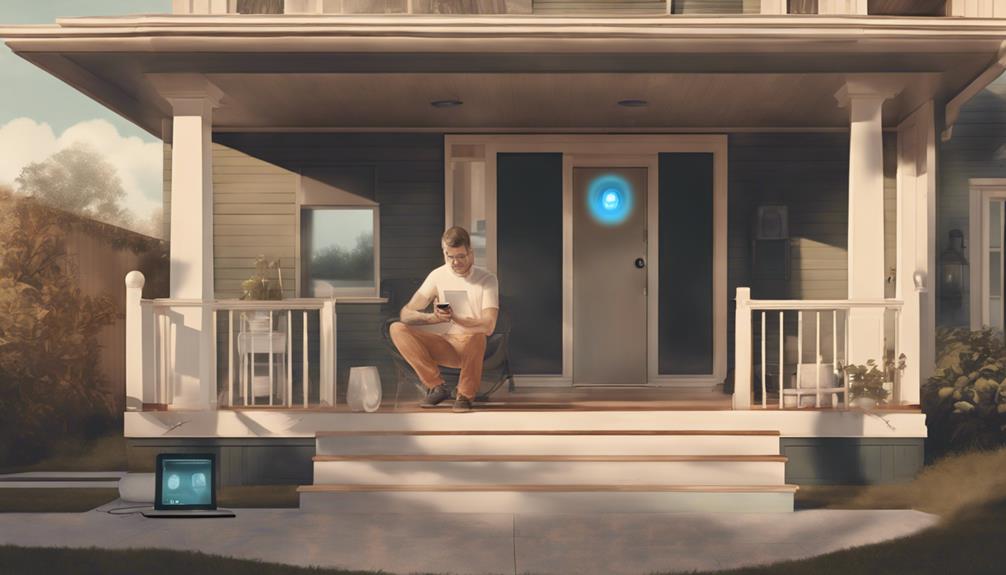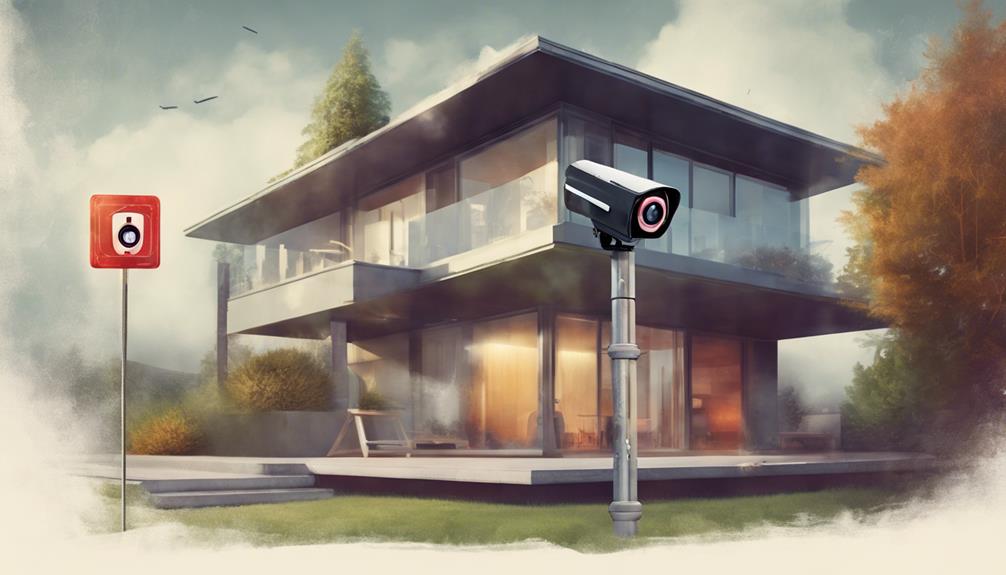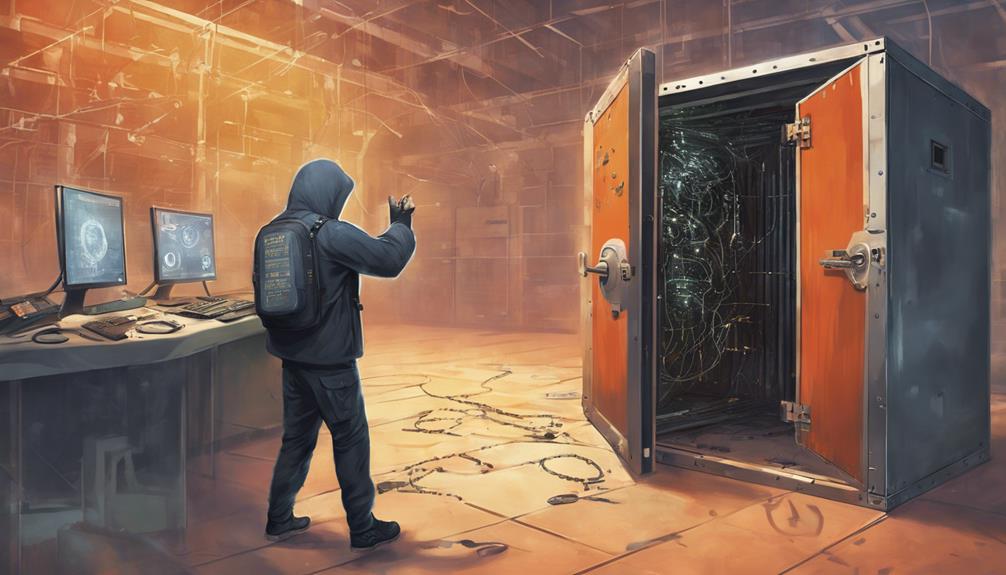To guarantee your home security camera is safe from hackers when connected to a phone app, prioritize robust encryption protocols like WPA3 or WPA2, two-factor authentication, HTTPS encryption, and firewall activation. Reputable brands such as Simplisafe, Google, and Vivint emphasize security through advanced encryption and regular updates. Implement end-to-end encryption on the camera's phone app, update software regularly, and use strong login credentials to enhance security. For peace of mind, enable features like biometric authentication and two-factor authentication. Advanced security measures and firmware updates are essential for hacker-proof cameras, offering enhanced protection against cyber threats.
Key Takeaways
- Choose reputable brands with advanced encryption.
- Enable Two-Factor Authentication for added security.
- Regularly update camera firmware for patches.
- Utilize secure login methods on the phone app.
- Implement encryption and firewall settings for remote access.
Importance of Secure Home Cameras
Ensuring the security of your home cameras is vital in safeguarding your privacy and property from unauthorized access and potential cyber threats. Home security cameras equipped with advanced encryption play an essential role in protecting your footage and personal data.
By utilizing secure phone apps, these cameras allow for convenient remote access without compromising your network's safety. Cybercriminals are constantly seeking to exploit vulnerabilities in security cameras, making it important to invest in systems with robust security features.
High-quality encryption not only prevents hackers from gaining unauthorized access to your live feeds but also provides peace of mind and protection against potential hacking threats. Therefore, when selecting a home security camera system, it is important to prioritize the security measures in place to deter cybercriminals and safeguard your privacy effectively.
Secure Connection Methods for Cameras

When setting up a home security camera system, it is essential to prioritize secure connection methods. Utilize encryption protocols like WPA3 or WPA2 to safeguard data transmission between the camera and your phone app.
Implement two-factor authentication and guarantee secure remote access to prevent unauthorized entry into your camera feed.
Encryption for Data
To guarantee the security of your home security camera feed, implementing robust encryption protocols is essential for safeguarding your data from potential cyber threats. Encryption plays an important role in ensuring that your camera feed is securely transmitted and protected from hackers. Secure connection methods such as HTTPS encryption on camera login pages help prevent unauthorized access to your device. It is important to verify that your camera utilizes encryption protocols like WPA3 or WPA2 to safeguard your data from potential breaches. Additionally, activating encryption and firewall features on your camera adds an extra layer of protection against cyber threats. Cameras with end-to-end encryption are recommended as they secure your livestreams and prevent interception by malicious actors.
| Secure Connection Methods | Importance |
|---|---|
| HTTPS Encryption | High |
| WPA3/WPA2 Encryption | Critical |
| Firewall Activation | Essential |
| End-to-End Encryption | Recommended |
| Data Protection | Essential |
Two-Factor Authentication
Implementing two-factor authentication for your home security camera system enhances the overall security of your camera's connection by requiring an additional verification step beyond just a password.
This extra layer of security helps to reduce the risk of unauthorized access to your camera's app. Two-factor authentication offers various options for verification, such as receiving a text message, a phone call, an email, or using an authenticator app to generate one-time codes.
Utilizing an authenticator app like Authy or Google Authenticator can further strengthen the security of your camera's connection. Even if your camera's password is compromised, two-factor authentication acts as a barrier to prevent unauthorized access.
Secure Remote Access
Secure remote access for home security cameras necessitates the utilization of encrypted connections such as HTTPS for login pages to guarantee the protection of sensitive data during access.
When setting up remote access to your security cameras, consider the following:
- Implement Two-factor authentication (2FA) to add an extra layer of security when accessing camera feeds remotely.
- Make sure your cameras support secure connection methods like SSL/TLS encryption to safeguard data transmission against potential breaches.
- Use strong, unique passwords to prevent unauthorized access and avoid connecting to public Wi-Fi networks which may expose your camera feed to security risks.
Additionally, it is vital to regularly update your camera's firmware to patch any security vulnerabilities that hackers could exploit.
Built-in Security Features for Protection

Home security cameras equipped with advanced encryption protocols offer a robust defense against potential cyber threats.
By ensuring the camera login page URL begins with 'https' and verifying encryption on the camera's webpage, users can establish a secure connection to protect their livestream feed.
Implementing encryption measures not only safeguards sensitive data but also enhances privacy settings control for a more secure viewing experience.
Secure Remote Access
Implementing advanced encryption protocols and robust firewall mechanisms, home security cameras offer secure remote access features to protect against unauthorized intrusion and safeguard camera feeds from potential hacking risks.
To guarantee the security of remote access, cameras implement HTTPS URLs and encryption on login pages. Activating two-factor authentication on the camera app adds an extra layer of security, making it harder for hackers to gain unauthorized access.
Additionally, restricting remote viewing permissions to specific devices or accounts enhances the overall security of the camera feed, preventing unauthorized individuals from tapping into the live stream.
Another important aspect is choosing a camera that allows for disabling remote viewing when not in use, further safeguarding against potential breaches.
Privacy Settings Control
Implementing robust privacy settings control is paramount in fortifying the security features of home security cameras, ensuring protection against potential breaches and unauthorized access.
Many home security cameras offer privacy settings controls that allow users to customize security features, such as encryption, secure login pages, and firewall protection, to enhance resistance to hacking attempts. These privacy settings control options include enabling encryption, setting up firewall protection, and verifying encryption on the camera's webpage.
By utilizing these features, users can secure their camera feed from unauthorized access, safeguarding their privacy and ensuring data protection. Enabling privacy settings controls and encryption provides users with the ability to safely watch their camera feed remotely without compromising security.
Encryption for Data
Robust encryption features integrated into home security cameras play a pivotal role in safeguarding sensitive data during transmission and storage. These encryption measures guarantee that data is scrambled into unreadable code, making it secure from unauthorized access.
Advanced Encryption Standard (AES), a widely adopted encryption standard, provides robust security for camera data, ensuring that it remains protected from potential breaches.
Encryption protocols such as HTTPS and SSL/TLS are utilized to safeguard camera feeds, preventing interception by malicious hackers and maintaining the integrity of the data during transmission.
Additionally, effective encryption key management is essential for securely encrypting and decrypting camera data, ensuring that only authorized individuals can access the information.
Choosing a Reputable Brand

When selecting a home security camera, prioritizing a reputable brand is crucial for guaranteeing robust security measures and reliable performance. Trusted brands like Simplisafe, Google, and Vivint place a high emphasis on security to safeguard home security cameras from potential hackers. These companies invest in advanced encryption protocols, regular security updates, and two-factor authentication to provide enhanced protection for users' privacy and data.
By opting for a well-known and trusted brand, individuals can greatly reduce the risk of security breaches and ensure the continued protection of their home security camera system. Reputable companies actively monitor for vulnerabilities and promptly address any security concerns that may arise, demonstrating a commitment to maintaining the highest standards of protection for their customers.
Ultimately, choosing a brand with a strong track record in security measures offers peace of mind and confidence in the security and performance of your home security camera setup.
Ensuring Secure Monitoring via Phone App

To maintain a high level of security and privacy in home monitoring, ensuring secure access via the camera's phone app is essential. When setting up your security camera system, consider the following measures to enhance secure monitoring:
- Implement end-to-end encryption on the camera's phone app to safeguard data transmission.
- Regularly update the camera app with security patches and software updates to address any vulnerabilities promptly.
- Opt for a camera system that offers advanced security features like two-factor authentication for an added layer of protection.
In addition to these steps, it is vital to enable secure login methods such as biometric authentication or PIN codes on the phone app.
Regularly reviewing and updating privacy settings within the camera app can further enhance the overall security of your monitoring setup.
Peace of Mind With Hacker-Proof Cameras

Reputable camera brands like Reolink provide advanced security features such as encryption and secure login options to guarantee peace of mind with hacker-proof cameras. Security camera manufacturers understand the importance of safeguarding these devices from potential breaches.
By avoiding default username and password combinations and opting for unique, strong credentials, users can greatly enhance the security of their cameras. Implementing Two-Factor Authentication (2FA) adds an extra layer of protection against unauthorized access to the camera feed.
Regularly updating the camera firmware is essential as it patches vulnerabilities that hackers may exploit. Enabling encryption and firewall settings on the camera can further prevent unauthorized entry. Additionally, cameras with privacy zones, shutters, or encryption for remote access offer enhanced security measures against potential cyber threats.
It is crucial for users to be proactive in securing their smart devices and ensuring that their cameras remain well-protected against malicious intrusions.
Frequently Asked Questions
Which Home Security Camera Cannot Be Hacked?
When selecting a home security camera, prioritize reputable brands like Simplisafe, Google, and Vivint. These companies prioritize security features, enforce Two-Factor Authentication (2FA), and have minimal known breaches, reducing the risk of hacking.
Can Someone Hack Into Your Home Security Camera?
Home security cameras are vulnerable to hacking due to weak passwords and outdated firmware. Immediate actions like changing default credentials and updating firmware can mitigate risks. Vigilance against unauthorized access is essential for camera security.
Are Security Camera Apps Safe?
Security camera apps' safety hinges on robust encryption, adherence to best practices, and regular security audits. Choosing reputable companies with a history of updates, enabling two-factor authentication, and keeping apps updated are crucial for enhancing security.
Can I Connect My Security Camera to My Phone?
Connecting your security camera to your phone allows for convenient remote monitoring. By utilizing secure connections like WiFi or the internet, you can easily set up and configure your camera with your phone app for seamless surveillance.
Conclusion
In the domain of home security, it is crucial to choose a camera system that prioritizes protection against hackers.
By selecting a reputable brand with secure connection methods and built-in security features, homeowners can guarantee the safety of their monitoring systems.
Just as a sturdy lock safeguards a door, a hacker-proof camera provides peace of mind and protection for one's home.









